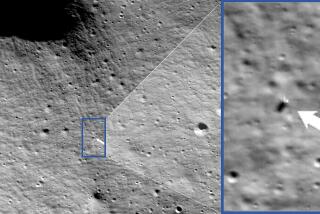Russia spacecraft aimed at Mars moon headed for Earth crash
An ill-fated 14.6-ton Russian spacecraft built to explore the Martian moon Phobos is expected to crash back to Earth this weekend, Russian officials said.
Exactly where and when Phobos-Ground will strike, nobody knows. But scientists say it could fall as far north as London or as far south as Patagonia, leaving most populated portions of the planet at risk. Most of the craft will burn up as it reenters the atmosphere, and because the majority of Earth’s surface is covered by water, chances are the space vehicle won’t crash on land.
A number of conditions, including weather and the craft’s position as it reenters the atmosphere, will influence its final fall to the ground. But the Russian Space Agency, or Roskosmos, said Friday on its website that its best estimate was that the craft would reenter Earth’s atmosphere shortly after noon Sunday (Pacific Time) off the southern coast of South America.
Phobos-Ground was to be an important mission for Roskosmos because it was the space agency’s first planetary mission beyond Earth in 15 years, said Anatoly Zak, editor of the website RussianSpaceWeb.com. The craft was designed to retrieve a sample from Phobos and return it to Earth.
“It was a jump-start for the Russian planetary exploration program,” said Zak, who is based in Morristown, N.J. “It was important culturally, scientifically, politically.”
A number of recent Russian launch failures raised the stakes for Phobos-Ground, others said.
Charles Vick, who follows the Russian space program at the military policy research firm GlobalSecurity.org in Alexandria, Va., said that lapses in quality control led Phobos-Ground to malfunction shortly after its November launch.
“There was testing that didn’t get done,” he said. “It goes back to an industrial base that is trying to reconstitute itself on limited funding.”
U.S. officials who track space debris kept their comments about the crippled craft to a minimum.
“It’s a Russian spacecraft; Russia speaks,” NASA spokeswoman Beth Dickey said.
Roskosmos did not respond to requests for an interview.
However, agency head Vladimir Popovkin acknowledged to the Russian newspaper Izvestia this week that limited funds and out-of-warranty components may have played a role in Phobos-Ground’s failure to leave Earth orbit.
Controversially, he also said he believed foreign interference could have played a role.
Because of the tilt of its orbit around Earth, scientists know Phobos-Ground will fall somewhere between 51.4 degrees north and 51.4 degrees south of the equator.
About 20 to 30 pieces are expected to survive and fall to Earth.
Those are most likely to fall in water, said Bill Ailor, director of the Center for Orbital and Reentry Debris Studies at the Aerospace Corp. in El Segundo.
The chances that any pieces would hit people are minuscule, Ailor said.
The Planetary Society in Pasadena was among the teams that sent experiments into space aboard Phobos-Ground. The Living Interplanetary Flight Experiment was intended to measure the effects of interplanetary travel on microbes that would have made the round-trip journey on a simulated space rock.
Executive Director Bill Nye said the experiment’s “biomodule” was among the pieces that might survive the descent. But he acknowledged that it probably would wind up in an ocean.
In September, the U.S. Upper Atmosphere Research Satellite, or UARS, made an uncontrolled reentry after sending data to atmospheric scientists for 14 years; its debris is believed to have fallen into the Pacific Ocean. Germany’s ROSAT astronomy satellite reentered Earth’s atmosphere somewhere over the Bay of Bengal in October.







